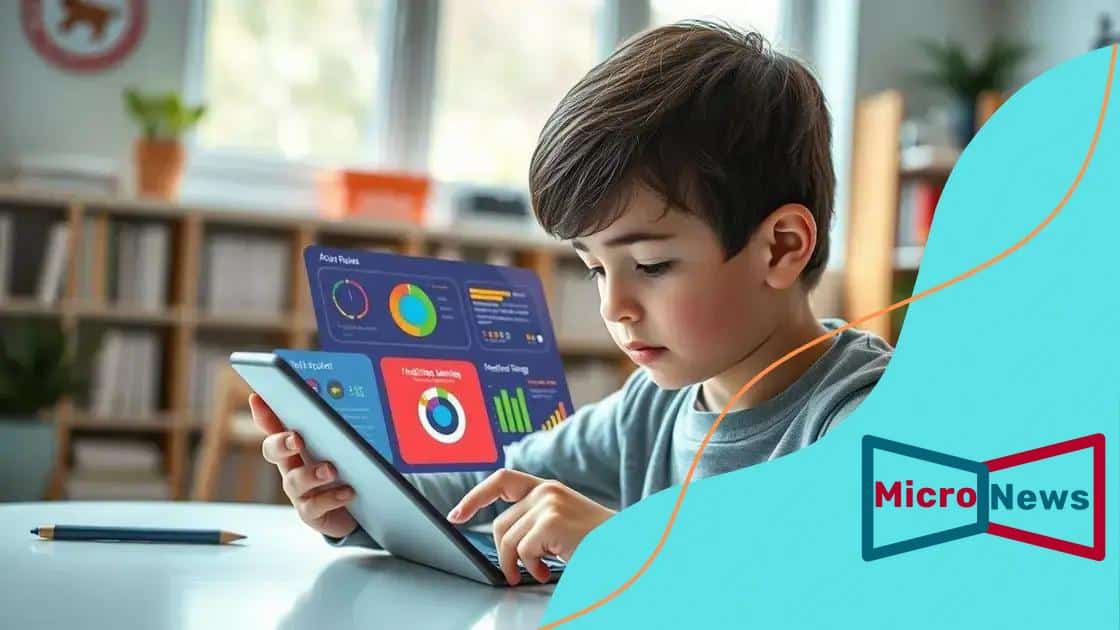AI tools for tracking and engaging students

AI tools for tracking and engaging students enhance personalized learning by analyzing individual progress and providing real-time feedback, ultimately boosting student performance and motivation in educational environments.
AI tools for tracking and engaging students are changing the way educators connect with learners. Imagine having insights at your fingertips that help tailor education to meet individual needs! Let’s dive into how these tools can transform the classroom experience.
Understanding AI tools for education
Understanding AI tools for education is essential for modern learning environments. These tools are designed to enhance both teaching and learning experiences.
AI tools can personalize education. They analyze students’ data, providing insights that help educators tailor their approaches to different learning styles. This individualized approach fosters better engagement among students.
Key Features of AI Tools
AI tools come packed with features that make education more interactive. For example:
- Real-time feedback: Teachers receive instant insights about student progress.
- Adaptive learning: Lessons adjust based on individual student performance.
- Data analytics: Identifies trends and areas that need improvements.
With these capabilities, AI tools also support teachers by reducing administrative burdens. By automating tasks, educators can focus on what truly matters—teaching.
Moreover, understanding AI tools for education means realizing how they facilitate student engagement. Interactive platforms encourage participation and motivate learners. These tools can incorporate gamification elements, making learning fun and engaging.
Examples of AI-powered Educational Tools
Some popular AI tools for education include:
- Knewton: Personalizes learning experiences through adaptive technology.
- Duolingo: Engages language learners with personalized practice.
- Smart Sparrow: Offers adaptive elearning platforms for various subjects.
These tools are just a starting point. As educators become more familiar with AI tools for education, they can explore even more solutions that fit their teaching styles and student needs.
Benefits of tracking student engagement
Tracking student engagement offers several advantages for both educators and learners. It provides valuable insights that can guide teaching methods and improve overall educational outcomes.
Monitoring engagement helps teachers identify which students may be struggling. By focusing on engagement metrics, educators can quickly recognize patterns and provide timely support to those who need it.
Key Benefits of Tracking Engagement
There are multiple benefits associated with monitoring student engagement:
- Improved academic performance: Engaged students are more likely to achieve higher grades.
- Enhanced motivation: Tracking allows teachers to personalize learning experiences, boosting students’ enthusiasm.
- Early intervention: Identifying disengaged students quickly can prevent further academic decline.
Additionally, understanding student engagement can help in adjusting lesson plans. Teachers can modify their approaches based on real-time data, ensuring the curriculum is effective and appealing.
Another noteworthy advantage is creating a supportive learning environment. By using engagement tools, teachers can foster a community where students feel encouraged to participate and express their ideas. Engaged students often collaborate better with peers, enhancing the overall classroom dynamic.
Long-term Impact on Learning
Recognizing the importance of tracking student engagement can lead to significant long-term benefits. Effective tracking helps in developing lifelong learners. When students are actively engaged, they are more likely to pursue knowledge beyond the classroom and take initiative in their education.
Moreover, consistent monitoring helps schools build data-driven strategies. When institutions focus on engagement insights, they can improve not only individual performance but also overall school success.
How AI enhances personalized learning

AI enhances personalized learning by providing individual pathways for students. By analyzing unique learning patterns, AI can tailor educational experiences to fit each learner’s needs.
Personalized learning means that students can learn at their own pace, allowing them to grasp concepts thoroughly before moving on. This approach helps students build confidence and fosters a love for learning.
Key Features of AI in Personalized Learning
AI technology uses various features to support personalized learning:
- Adaptive learning systems: These systems adjust content based on student performance.
- Smart content creation: AI can generate customized lessons and quizzes that align with individual skills.
- Learning analytics: Through data analysis, educators get insights into each student’s progress and challenges.
By utilizing these features, educators can ensure that students receive support tailored to their specific needs. This flexibility allows learners to explore subjects that interest them, making education more engaging.
Another significant aspect is the use of AI in providing real-time feedback. Students can receive instant responses to their queries, helping them correct mistakes immediately. This immediacy promotes a deeper understanding of the material and sustains their motivation.
Benefits of AI in Personalized Learning
The benefits of integrating AI into personalized learning are clear:
- Enhanced engagement: Students are more involved when materials resonate with their interests and strengths.
- Improved retention: Tailored strategies help students remember and apply what they have learned.
- Increased efficiency: Teachers can focus on teaching rather than administrative tasks, optimizing their time spent with students.
When educators embrace AI, they create a supportive environment where every student can thrive. By enhancing personalized learning, AI not only prepares students for academic success but also nurtures critical thinking skills essential for their future.
Top AI tools for monitoring performance
There are several top AI tools that can significantly enhance the monitoring of student performance. These tools provide insights that help educators understand how students learn and where they may need additional support.
Monitoring performance is crucial in education, as it allows teachers to evaluate the effectiveness of their teaching methods. With the right tools, educators can track student progress in a dynamic and efficient way.
Leading AI Tools for Performance Monitoring
Some of the most effective AI tools for monitoring performance include:
- Google Classroom: This platform integrates with various AI features to help teachers track assignments and student engagement.
- Edmodo: Offers analytics tools to monitor student submissions and participation.
- Classcraft: Utilizes gamification and AI to track student progress and engagement.
- Seen: Focuses on analyzing student data to improve classroom strategies.
These tools not only help in tracking performance but also provide valuable feedback that can be used to adjust teaching methods. By leveraging real-time data, educators can make informed decisions on how to support individual students.
Furthermore, understanding performance metrics can empower students. They can view their progress and take ownership of their learning journey. This transparency can foster a culture of self-improvement and motivation among learners.
The Role of Data Analytics
Data analytics plays a crucial role in these AI tools. They can identify trends in student performance and engagement, which are key factors in tailoring educational experiences. Data-driven insights enable teachers to refine their approaches, making education more personalized and effective.
Incorporating AI tools into educational environments allows schools to prepare students better for their future. By utilizing these advanced technologies, institutions can create a more efficient and engaging learning experience.
Implementing AI in educational environments
Implementing AI in educational environments can significantly transform the way teaching and learning occur. Schools and institutions are discovering that leveraging AI allows them to offer personalized experiences that cater to student needs.
AI technology can help streamline various educational processes. By integrating this technology, schools can enhance administrative efficiency, allowing teachers to focus more on instruction.
Steps to Implement AI
Implementing AI requires careful planning. Here are essential steps to consider:
- Assess needs: Determine what challenges AI can address in the educational setting.
- Select appropriate tools: Research AI tools that match the school’s goals, such as learning management systems or data analytics software.
- Train staff: Provide professional development opportunities to ensure teachers can effectively use AI technologies.
- Monitor and evaluate: Regularly assess the impact of AI on learning outcomes and adjust strategies as needed.
These steps help schools create a structured approach to adopting AI, making the transition smoother for both educators and students.
Furthermore, fostering a culture that embraces technology is vital. Teachers and administrators should be encouraged to share their experiences and strategies. This collaboration can lead to innovative ideas on how to best integrate AI into daily activities.
Overcoming Challenges
While there are numerous benefits, it’s also essential to acknowledge potential challenges. Issues such as data privacy and the digital divide can impact AI implementation. Schools must prioritize protecting student information and ensure all students have access to the necessary technology.
Additionally, maintaining an ongoing dialogue about the ethical use of AI in education can help address concerns. This conversation can prepare both educators and students to engage with AI responsibly and effectively.
By thoughtfully implementing AI in educational environments, schools can equip students with the skills they need for the future and create a more engaging learning experience.
In conclusion, implementing AI tools in education can significantly enhance the learning experience for both students and teachers. By personalizing learning paths, tracking engagement, and using data analytics, schools create environments where every learner can thrive. While challenges exist, with careful planning and a supportive culture, the potential benefits of AI far outweigh the obstacles. Together, educators can transform classrooms into innovative spaces that prepare students for the future.
FAQ – Frequently Asked Questions about AI in Education
How does AI personalize learning for students?
AI analyzes individual learning styles and progress, allowing for customized lesson plans that cater to each student’s needs.
What are the benefits of using AI tools in classrooms?
AI tools enhance engagement, improve tracking of student performance, and reduce administrative tasks for teachers.
How can teachers implement AI in their teaching?
Teachers can start by assessing their needs, selecting suitable AI tools, and undergoing training to use these technologies effectively.
What challenges might schools face when integrating AI?
Challenges include data privacy concerns, ensuring equal access to technology, and the need for ongoing training and support.





